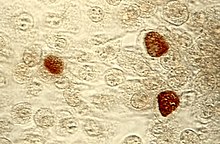
Back متدثرة تراخومية Arabic متدثره تراخوميه ARZ Chlamydia trachomatis Bulgarian Chlamydia trachomatis Catalan Chlamydia trachomatis Czech Chlamydia trachomatis Danish Chlamydia trachomatis German Chlamydia trachomatis Spanish Chlamydia trachomatis Basque کلامیدیا تراکوماتیس Persian
| Chlamydia trachomatis | |
|---|---|

| |
| Chlamydia trachomatis in brown | |
| Scientific classification | |
| Domain: | Bacteria |
| Phylum: | Chlamydiota |
| Class: | Chlamydiia |
| Order: | Chlamydiales |
| Family: | Chlamydiaceae |
| Genus: | Chlamydia |
| Species: | C. trachomatis
|
| Binomial name | |
| Chlamydia trachomatis (Busacca 1935) Rake 1957 emend. Everett et al. 1999[1]
| |
| Synonyms | |
| |
Chlamydia trachomatis (/kləˈmɪdiə trəˈkoʊmətɪs/) is a Gram-negative, anaerobic bacterium responsible for chlamydia and trachoma. C. trachomatis exists in two forms, an extracellular infectious elementary body (EB) and an intracellular non-infectious reticulate body (RB).[2] The EB attaches to host cells and enter the cell using effector proteins, where it transforms into the metabolically active RB. Inside the cell, RB's rapidly replicate before transitioning back to EB's, which are then released to infect new host cells.[3]
The earliest description of C. trachomatis was in 1907 by Stanislaus von Prowazek and Ludwig Halberstädter as a protozoa.[4] It was later thought to be a virus due to its small size and inability to grow in laboratories. It was not until 1966 when it was discovered as a bacterium by electron microscopy where its internal structures were observed.
There are currently 18 serovars of C. trachomatis, each associated with specific diseases affecting mucosal cells in the lungs, genital tracts, and ocular systems.[3] Infections are often asymptomatic, but can lead to severe complications such as pelvic inflammatory disease in women and epididymitis in men. The bacterium also causes urethritis, conjunctivitis, and lymphogranuloma venereum in both sexes. C. trachomatis genitourinary infections are diagnosed more frequently in women than in men, with the highest prevalence occurring in females aged 15 to 19 years of age.[5][6][7] Infants born from mothers with active chlamydia infections have a pulmonary infection rate that is less than 10%.[8] Globally, approximately 84 million people are affected by C. trachomatis eye infections, with 8 million cases resulting in blindness.[9] C. trachomatis is the leading infectious cause of blindness and the most common sexually transmitted bacterium.[3]
The impact of C. trachomatis on human health has been driving vaccine research since its discovery.[10] Currently, no vaccines are available, largely due to the complexity of the immunological pathways involved in C. trachomatis, which remains poorly understood. However, C. trachomatis infections may be treated with several antibiotics, with tetracycline being the preferred option.[11][12]
- ^ J.P. Euzéby. "Chlamydia". List of Prokaryotic names with Standing in Nomenclature. Retrieved 2008-09-11.
- ^ Wang Y, Kahane S, Cutcliffe LT, Skilton RJ, Lambden PR, Clarke IN (September 2011). "Development of a transformation system for Chlamydia trachomatis: restoration of glycogen biosynthesis by acquisition of a plasmid shuttle vector". PLOS Pathogens. 7 (9): e1002258. doi:10.1371/journal.ppat.1002258. PMC 3178582. PMID 21966270.
- ^ a b c Elwell C, Mirrashidi K, Engel J (2016). "Chlamydia cell biology and pathogenesis". Nature Reviews Microbiology. 14 (6): 385–400. doi:10.1038/nrmicro.2016.30. PMC 4886739. PMID 27108705.
- ^ Nunes A, Gomes JP (2014). "Evolution, Phylogeny, and molecular epidemiology of Chlamydia". Infection, Genetics and Evolution. 23: 49–64. Bibcode:2014InfGE..23...49N. doi:10.1016/j.meegid.2014.01.029. PMID 24509351.
- ^ Cite error: The named reference
:0was invoked but never defined (see the help page). - ^ Cite error: The named reference
:3was invoked but never defined (see the help page). - ^ Cite error: The named reference
Chlamydial Infectionswas invoked but never defined (see the help page). - ^ Cite error: The named reference
:1was invoked but never defined (see the help page). - ^ Cite error: The named reference
:4was invoked but never defined (see the help page). - ^ Kuo CC, Stephens RS, Bavoil PM, Kaltenboeck B (2015). "Chlamydia". In Whitman WB (ed.). Bergey's Manual of Systematics of Archaea and Bacteria. John Wiley & Sons. pp. 1–28. doi:10.1002/9781118960608.gbm00364. ISBN 9781118960608.
- ^ Cite error: The named reference
Malhotra2013was invoked but never defined (see the help page). - ^ Cite error: The named reference
:2was invoked but never defined (see the help page).